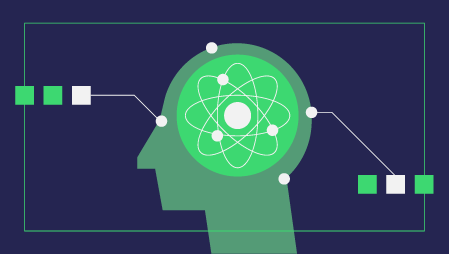Everyone agrees that machine learning will change RPA, but it’s not going to happen the way you might think.
The boom in robotic process automation (RPA) over the past few years has made it pretty clear that business processes in nearly every industry have an endless amount of bottlenecks to be resolved and efficiency improvements to be gained. Years before the full surge of RPA, McKinsey already estimated the annual impact of knowledge work automation to be around $6 trillion in 2025.
Having followed the evolution of RPA from python scripts towards generalized platforms, I’ve witnessed quite a transformation. The tools and libraries available in RPA have improved over time, each iteration widening the variety of processes that can be automated and improving the overall automation rates further. I believe the addition of machine learning (ML) in the everyday toolbox of RPA developers is the next huge leap in the scope and effectiveness of process automation. And I am not alone. But there’s a catch. It will look very different from what all the hype would lead you to believe.
Why even care about machine learning?
Imagine RPA without if-else logic or variables. You could only automate simple and completely static click-through processes. As we gradually add in some variables and logic, we can start automating more complex and impactful processes. The more complex the process you want to automate, the more logic rules you need to add, and the more edge cases you need to consider. The burden on the RPA developer’s rule system grows exponentially. See where I’m going with this?
The law of diminishing returns dictates that at some point (surprisingly soon) the development of rule systems becomes so costly that automating the process is no longer worth the investment. This is where machine learning comes in. Used correctly, it can easily outsmart any traditional rule system while requiring far fewer resources. And even better, it unlocks automations so complex that attempting to solve them with rule systems would be laughable. In the end, the law of diminishing returns naturally also applies to machine learning, but I’ll soon get to why it doesn’t actually matter right now.

But wait, isn’t machine learning crazily expensive?
Yes and no. By choosing the right approach and tools, you get to pick between crazy expensive and crazy profitable. I like to divide automation into two categories:
1. High impact, low volume automation
2. Low impact, high volume automation
The first category contains all the hyped-up applications such as personal AI assistants, big data business analytics, automated R&D and other concepts that bring promises of massive impact in the business. These are launched as huge machine learning projects with grand ambitions but tend to become just PR stunts and fail to deliver much actual value. Why? The answer is in the graph. The high impact applications require an enormous investment to squeeze out the final 2% increase in accuracy needed to make it work, pressing the ROI to negative. Usually these projects drain so many resources that the company is forced to cut the costs and shut them down.
The second category is all about efficiency. It has far less media appeal but don’t be fooled by its low profile nature. This is where you’ll find realizable profits and true organizational change. Things like invoice processing, categorizing customer complaints and qualifying sales leads don’t sound like world-changing automations. But added up together, they ramp up the efficiency of your company by an order of magnitude. Think about the impact of the internet. You don’t have one massive internet project, but instead, the internet is embedded in every single function around your company. The same will happen with machine learning. You want to be in the profitable high efficiency zone. So instead of doing big ML projects, embed small ML into your day-to-day RPA work and be amazed.
How do I do that? Our data scientists are super busy.
Simply, choose tools that allow your RPA team to use machine learning without relying on the data science team for every automation. There are machine learning tools that are aimed at developers and skip over all the hassle of model training, hosting and maintenance.
Naturally, you could always get a higher performance with a custom model made by a data science team, but you will need to evaluate and justify whether it’s worth the investment. When the RPA team can use machine learning themselves, the threshold for incorporating intelligence in process automation plummets. You’ll start seeing it everywhere.
Most ML tools are aimed at data scientists to optimize their work, so you’ll need to do some digging to find developer-centric solutions. I’ll get back to this at the end of the post.
Ok, where should I start?
Have a look at your current automations. Do some of them require constant updating in their rule system or do they need frequent human intervention? If so, could these bottlenecks be resolved with some intelligence?
Another great source is your RPA backlog. Are there automations that have been sitting there with mid-high priority for a while but have never moved forward? It’s typically the ones that have a bit of complexity that get stuck in the backlog.
Automations where intelligence is necessary are generally in one of the following boxes:
- Has unreliable input data: E.g. the user has not filled in all the necessary information in a form or they have made typos.
- Requires a complex rule system: E.g. identifying if an entry already exists in the database but in a different format (Corp Inc. vs Corp).
- Requires cognitive decisions: E.g. a complaint ticket needs to be assigned to the right customer service agent based on it’s category or urgency.
- Environment or data changes frequently: E.g. the products sold in retail change constantly when new products are introduced and old ones discontinued.

” Where to start with small ML” Where to start with small ML
Can I do it on my RPA platform?
Yes. The whole point is to make machine learning a normal tool in your daily RPA toolbox and remove any points of friction in between. At least aito.ai is already compatible with Robot Framework, UiPath, BluePrism and all the other major players. Using solutions like this doesn’t require much more than sending HTTP requests, a standard function in any RPA platform. We’re working on guides and tutorials for each platform to help you get started, and we’re launching libraries and components to make using ML even easier through the platforms.





